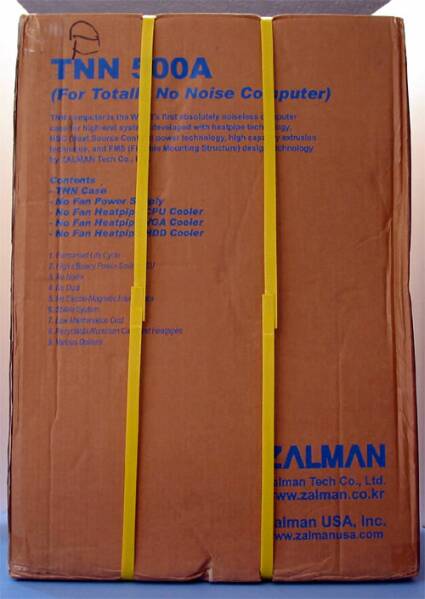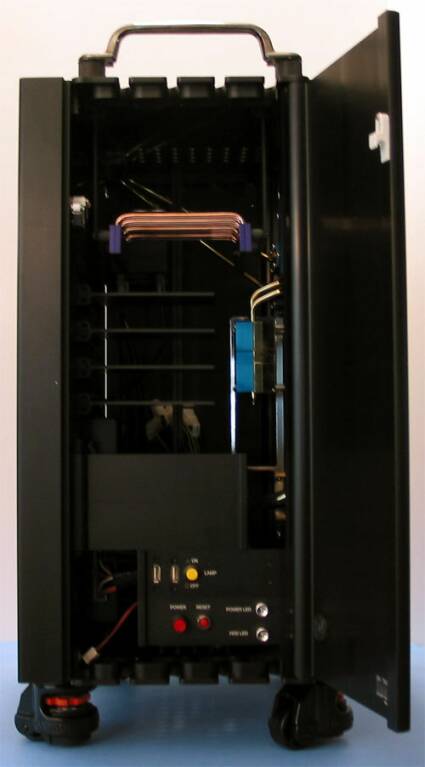Noiseless Computing: New Case Innovation From Zalman
Introduction
In a big heavy box arrives the TNN 500A from Zalman. Will this new innovation in silent computing technology become the template for the future of case cooling?
The quest for noiseless computing has been highly sought by computer users over the past several years. Increased processor speeds, coupled with higher temperature components, have created an internal case thermal envelope that typically requires multiple fans to dissipate the increased temperature loads of higher performance components. In today's environment of high performance CPUs, video cards and other heat generating peripherals, the common gripes that it is possible to "cook an egg" or "warm your coffee" on a typical modern computer are not that far fetched.
Many manufacturers have grappled with the difficulty of tempering a highly evolved thermal dissipation requirement with the dual requirement of a quiet computing environment. This has more significance for the "overclocking" crowd who raise their internal case thermals by ramping up the frequencies of their chosen parts. The solutions that many manufacturers and users have employed seem to continue to create more fans into the PC chassis environment. Unfortunately, more fans for cooling equals more noise. While it is possible to choose fans that either spin at lower RPMs or that are inherently more quiet than the generic, off-the-shelf fan varieties that some users employ, an increased number of fans inside a case still connote more noise.
In the typical baseline PC configuration,most users have an average of six fans installed. There is one fan in the front of the case, one in the rear, one fan on the CPU heatsink and one fan on the video card. These are the four main fans that most users recognize when they open their computer case; but many users forget that most modern power supplies employ two fans, as well, bringing the total number to six. A user can employ a combination temperature monitoring/fan bus scheme to slow the RPMs of the fans to a more tolerable level, but doing so raises the internal temperature of the chassis and the components, since lower RPMs equals less air being circulated by the fans (CFMs) than if the fans were running at full RPM speed. Some motherboard manufacturers have even introduced "smart" fan type technology that is built into their motherboards. No matter, if fans are spinning, noise is being generated.
As we have seen in some of our recent case reviews, many case manufacturers have begun a trend of using larger fans in the 92mm/120mm range to allow for better airflow, while at the same time using lower RPMs to help reduce the noise factor. While this trend is good in many aspects, it still involves the use of fans; and by their sheer rotation they create noise. Is it possible to create a totally silent passive cooling solution while at the same time providing ample cooling for the vital components inside a PC? Zalman seems to think so, and has taken quiet computing to the extreme with their introduction of the TNN 500A chassis that is designed for "noiseless computing."
Totally No Noise Computing With The TNN 500A
A look inside the TNN 500A with the front door open.
Zalman is best known for its innovative CPU/Heatsink solutions. Based in Seoul, Korea, Zalman continues to develop and build innovative cooling solutions for a variety of applications. It is no surprise that Zalman is leading the charge in what they refer to as "totally no noise computing;" hence, the TNN moniker that denotes Zalman's initial entry into the PC chassis marketplace. Let's face it: there are times when a high performance PC platform that yields no noise is required. Recording studio applications are one of the best that come to mind. With the increased use of PCs in both audio and video productions, the need for and advantages of a noiseless solution are huge.
Get Tom's Hardware's best news and in-depth reviews, straight to your inbox.
Zalman has recognized the need for such an evolution. However, the creation of a passive cooling environment able to handle the extremely complex thermal envelope of the modern PC is no small feat. The surface area of even the largest passive heatsinks will simply not suffice without using a fan to move the heat away from the heatsink. Zalman's revolutionary new approach involves a combination of heat pipes. These heat pipes move the heat to the outside of the chassis, which is nothing more than one large heatsink surface.
The entire TNN 500A chassis, in fact, is a giant heatsink. Both the right and left side panels of the TNN 500A chassis feature natural convection cooled heatsinks; with the huge 400mm width of these side panels, both side panels of the case serve to radiate the heat to the outside of the chassis.
Current page: Introduction
Next Page Totally No Noise Computing With The TNN 500A, Continued
